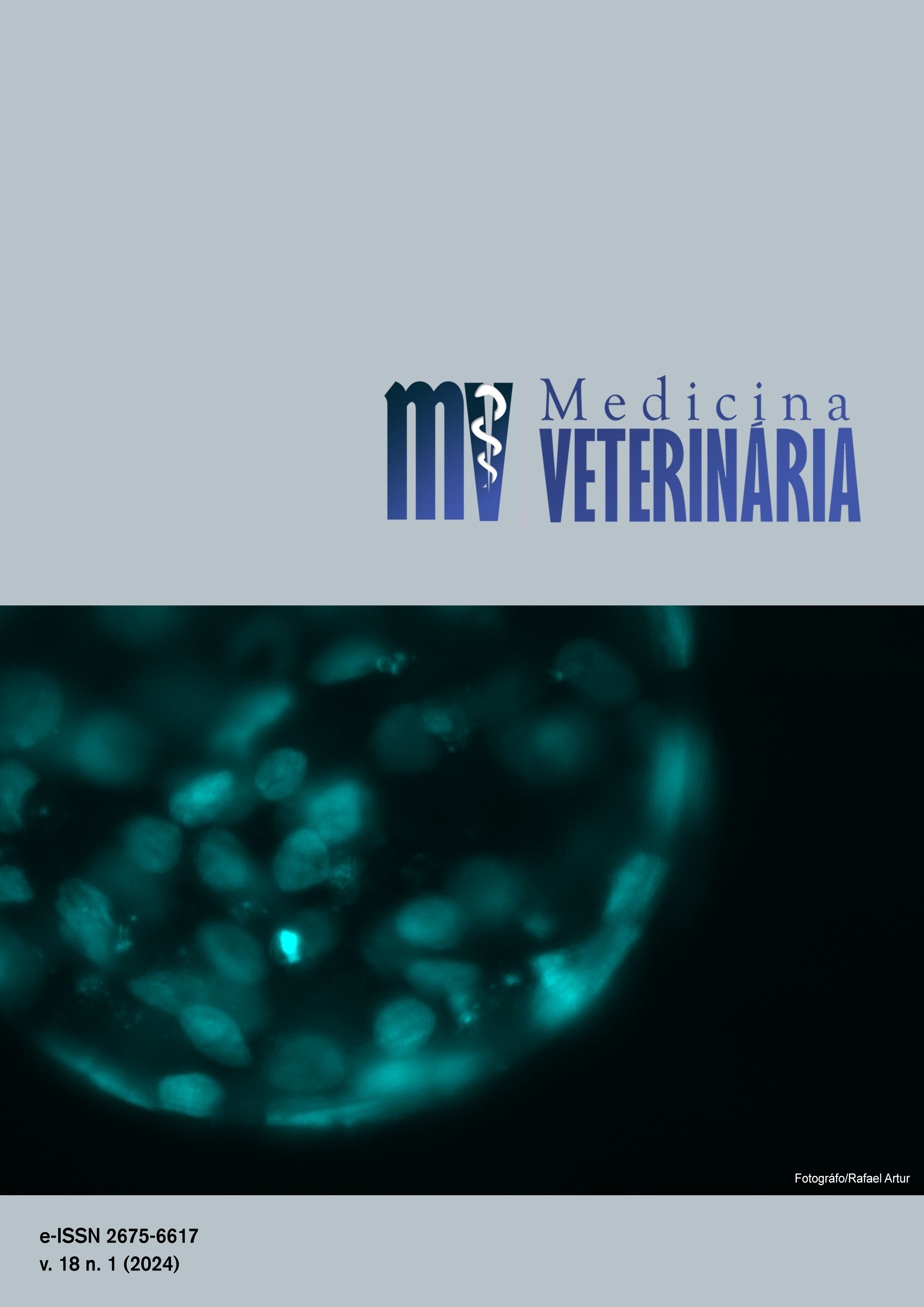FUNGAL OSTEOMYELITIS CAUSED BY Penicillium sp. AND Acremonium sp. IN A DOG
DOI:
https://doi.org/10.26605/medvet-v18n1-6176Keywords:
Canine; Osteopathy; Fungus; Itraconazole; RadiographyAbstract
Osteomyelitis is a severe systemic infectious disease characterized by destructive and progressive bone inflammation, which is usually bacterial in origin, and occasionally viral or fungal. The objective was to report the case of a dog with fungal osteomyelitis, detailing the diagnosis and treatment evolution. A male, crossbreed dog, four months old, was treated at the Veterinary Hospital of the Federal University of Uberlândia (HOVET-UFU), presenting hyperthermia, hyporexia, reactive lymph nodes, lameness and open wound in the right forelimb (RF), in addition to secretion purulent and exposed bone. The radiograph showed Salter Harris I fractures in the physeal cartilages of the right ulna and signs of aggressive polyostotic bone lesion in RF. Fungal and bacterial cultures isolated Enterococcus sp., Penicillium sp. and Acremonium sp. The diagnosis obtained was fungal osteomyelitis. Based on the antibiogram and antifungigram, the drugs amoxicillin with potassium clavulanate, omeprazole and itraconazole were used and the animal was radiographically monitored every 30 days. After 150 days, signs of bone remodeling in the joint and adjacent bones were more evident and the treatment was terminated. The dog presented 28 months free of relapses. It should be noted that the medical management of a wound should not be directed solely at healing, requiring radiography and, in cases of suspected osteomyelitis, tests to exclude differential diagnoses, as well as to choose the most suitable drug, effective in each case.Downloads
References
Clegg, P.D. Osteomyelitis in the veterinary species. In: Percival S.L.; Knottenbelt, D.; Cochrane, C. Biofilms and Veterinary Medicine. New York: Springer, 2011. P.175-190.
Fossum, T.W. Cirurgia de pequenos animais. 5ª ed. Rio de janeiro: GEN Guanabara Koogan, 2021. 1584p.
Goodrich, L.L. Osteomyelitis in horses. Veterinary Clinics of North America: Equine Practice, 22(2): 389-417, 2006.
Hakamata, M. et al. Canine fungal osteomyelitis. Mycopathologia, 184(5): 707-708, 2019.
Johnson, J.M.; Johnson, A.L.; Eurell, J.A. Histological appearance of naturally occurring canine physeal fractures. Veterinary Surgery, 23(2): 81-6, 1994.
Kerl, M.E. Update on canine and feline fungal diseases. Veterinary Clinics of North America: Small Animal Practice, 33(4): 721-747, 2003.
Kyriakidis, I. et al. Clinical hepatotoxicity associated with antifungal agents. Expert Opinion Drug Safety, 16(2): 149-165, 2017.
Langlois, D.K. et al. Clinical, morphological, and molecular characterization of Penicillium canis sp. Nov., isolated from a dog with osteomyelitis. Journal of Clinical Microbiology,52(7): 2447-2453, 2014.
Legendre, A.M. Blastomycosis. In: Greene, C.E. Infectious diseases of the dog and cat. 3rd ed. St. Louis, Missouri: Elsevier, 2006. P. 569–576.
Lew, D.P.; Waldvogel, F.A. Osteomyelitis. The Lancet, 364(9431): 369-379, 2004.
Lorimier, L.P.; Fan, T.M. Delayed diagnosis of fungal osteomyelitis with early scintigraphic lesions in a dog. Canadian Veterinary Journal, 51(12): 1394-1396, 2010.
Mamone, C.M. et al. What is your diagnosis? Fungal osteomyelitis. Journal of the American Veterinary Medical Association, 244(12): 1373-1375, 2014.
Martín, M.G. et al. Microbiological aspects of osteomyelitis in veterinary medicine: drawing parallels to the infection in human medicine. Veterinary Quartely, 42(1): 1-11, 2022.
Miyakawa, K. et al. Pathology in practice. Journal of the American Veterinary Medical Association, 238(1): 51-53, 2011.
Reese, J.H.J.B. Surgical approaches to the management of osteomyelitis. In: Jauregui, L.E. Diagnosis and management of bone infections. New York: Marcel Dekker Inc, 1995. p.425–49.
Singer, A. D. et al. A systematic, multimodality approach to emergency elbow Imaging. Clinical Imaging, 40 (1): 13-22, 2016.
Simionato, A.C.; Ramos, M.C.C.; Coutinho, S.D.A. Isolamento de bactérias aeróbias e sua sensibilidade a antimicrobianos em processos de osteomielite canina. Arquivo Brasileiro Medicina Veterinária e Zootecnia, 55(2): 148-154, 2003.
Shaver, S.L.; Foy, D.S.; Carter, T.D. Clinical features, treatment, and outcome of dogs with Coccidioides osteomyelitis. Journal American Veterinary Medical Association, 260(1): 63-70, 2021.
Thrall, D.E. Infecções ósseas fúngicas. In: ______ Diagnóstico de Radiologia Veterinária. St Louis: Elsevier, 2013. p.309–310.
Wigney, D. et al. Osteomyelitis associated with Penicillium verruculosumin a German shepherd dog. Journal of Small Animal Practice, 31(1): 449–452, 1990.
Downloads
Published
How to Cite
Issue
Section
License
Copyright (c) 2024 Sheila Santana de Mello, Lídia Maria Amaro Vasconcelos, Vanessa Martins Fayad Milken, Francisco Claudio Dantas Mota, Alessandra Aparecida Medeiros-Ronchi

This work is licensed under a Creative Commons Attribution-NonCommercial-ShareAlike 4.0 International License.
A Revista de Medicina Veterinária permite que o autor retenha os direitos de publicação sem restrições, utilizando para tal a licença Creative Commons CC BY-NC-SA 4.0.
De acordo com os termos seguintes:
Atribuição — Você deve dar o crédito apropriado, prover um link para a licença e indicar se mudanças foram feitas. Você deve fazê-lo em qualquer circunstância razoável, mas de nenhuma maneira que sugira que o licenciante apoia você ou o seu uso.
NãoComercial — Você não pode usar o material para fins comerciais.
CompartilhaIgual — Se você remixar, transformar, ou criar a partir do material, tem de distribuir as suas contribuições sob a mesma licença que o original.
Sem restrições adicionais — Você não pode aplicar termos jurídicos ou medidas de caráter tecnológico que restrinjam legalmente outros de fazerem algo que a licença permita.







